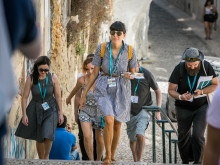LAG Pays des Condruses
The LAG Pays des Condruses is composed of seven municipalities: Anthisnes, Clavier, Marchin, Modave, Nandrin, Ouffet and Tinlot. The surface of the territory is 300 km². The Condruses Land is a young region (ageing rate is low). Population increase each year so it’s an attractive region.The third sector is the most important sector of activities: health, local administration, retails, elderly sector, etc. Building represent also an important part of companies, mainly in small family business and some public works companies. The extractive industry is still present for stoneware and granite. It’s also an important region for removal of water for Brussels (based on underground water-collecting galleries) and Liège. 10 years ago, steel industry was relevant, but it decrease and it could disappear definitively. Some start-ups develops their activities on our territory like Phytesia (Orchid for temperate region), Chanvr’Eco (Hemp for insulation), a pharmaceutical company or a spirulina grower connected to a biogas installation.
In our territory, the agriculture is a familial agriculture, mainly based on cattle breeding for meat and for milk, intensive crop growing (wheat, corn, sugar beet, colza) and potatoes growing. The average age of the farmers is around 55 years. And often, there’s no successor.
The numbers of farmers decrease each years but the farms are becoming bigger and bigger, more and more capitalistic. Access to land is a real problem especially for people that not descended from a farmer’s family and is very expensive. One hectare cost approximatively 30 000 € for a crop field and 20 000 € for a meadow. This problem is a reality for new farmers Urbanization for residential needs and the development of retail and business centers along national roads is a factor of the farmland high prices. In Wallonia, some urbanists says: “there’s no more real countryside, all the territory is a suburban area”. It is a real problem for farming and the interaction between farmers and the citizens. The way of life is more and more urban, people are disconnected from the land and the way to produce quality product. In Wallonia, rural communities and towns are very close, for example, by car, Marchin is situated at 30 minutes form Liège (200 000 inhabitants) and Namur (100 000 inhabitants). So the countryside interested the middle class for the living environment and the dominant model of urbanization remains the 4 facades houses with green gardens.
SOME RELATED NETWORKS
AGRI-URBAN
BioCanteens
News



